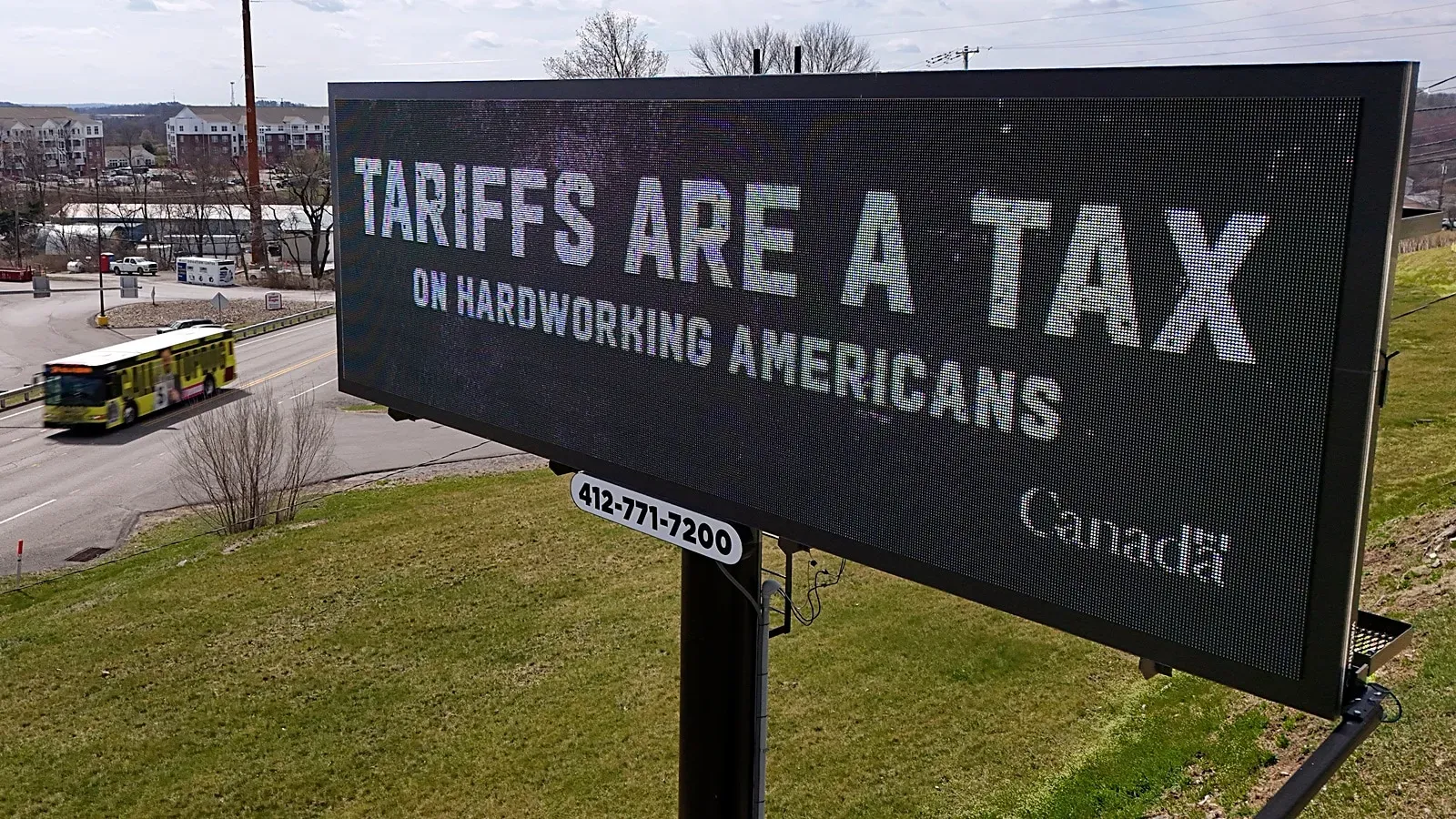Trump Tariffs Impact: What You Need to Know for Your Finances

The impact of Trump tariffs extends beyond American borders, influencing economies worldwide and directly affecting consumers. As the US imposes new import taxes, the repercussions are being felt in the UK, where nearly all goods face a substantial 10% tariff. This escalation in the trade war could lead to heightened consumer prices, raising concerns about the economic impact of tariffs on everyday goods. Analysts warn that as companies absorb these charges, American firms may inevitably pass the costs onto consumers, resulting in increased UK import costs as well. The pressing question remains: how will these tariffs shape the financial landscape for both consumers and businesses alike?
Exploring the repercussions of recent import tax hikes reveals a broader narrative of trade dynamics and international business strategies. These elevated charges, intended as a countermeasure in an ongoing trade conflict, signal potential challenges for retailers and manufacturers across the globe. With the ripple effects of tariff imposition affecting not only US markets but also international trade relations, consumers might soon face higher prices driven by supply chain adjustments and currency fluctuations. This examination of import duties highlights the interconnectedness of global economies and the necessary adaptation required from all stakeholders involved in the commerce sector.
The Economic Impact of Trump Tariffs on Consumers
The economic impact of Trump’s tariffs extends beyond the shores of the United States, significantly affecting consumers worldwide. With the UK facing a 10% tariff on most goods exported to America, British businesses are likely to adjust their prices as they grapple with increased import costs. As these companies pass on their expenses to consumers, shoppers may soon notice a rise in prices on everything from electronics to clothing. This shift not only burdens the wallets of UK consumers but also threatens to alter spending patterns, potentially leading to reduced consumption and affecting overall economic stability.
Moreover, the indirect effects of the tariffs could further exacerbate the situation. As American companies adjust their pricing strategies in response to elevated costs due to tariffs, UK consumers will feel the ripple effects of a global supply chain facing disruption. With increasing import costs, consumer prices on a range of products may rise, leading to inflationary pressures that could squeeze household budgets. It is essential for consumers to stay informed about these developments as they could impact their purchasing decisions and financial planning moving forward.
How US Tariffs Influence UK Import Costs
US tariffs, particularly those imposed under President Trump, play a pivotal role in shaping import costs for UK businesses. The newly established 10% tariff on nearly all goods impacts not just the trade between the US and the UK, but also influences suppliers and pricing structures globally. As trade war effects ripple through the marketplace, UK importers may find they have to reassess their strategies, sourcing goods from alternate suppliers or facing higher costs from their existing ones. These changes will inevitably trickle down, resulting in increased prices for consumers who rely on imported goods.
In addition to the immediate financial implications, the uncertainty surrounding tariffs can lead to a broader economic ripple effect. Businesses may react by adjusting their inventory levels to mitigate the anticipated increase in costs. This forethought could result in supply shortages, driving prices even higher. Furthermore, the fluctuating exchange rates following Trump’s tariff announcements cause uncertainty for UK businesses that engage in transatlantic trade. As they navigate these challenges, the importance of understanding how tariffs influence import costs becomes paramount, as it directly impacts both corporate profitability and consumer accessibility.
Consumer Prices Amidst Trade Wars
In the often tumultuous landscape of global trade, consumer prices serve as a barometer for broader economic health. The trade war instigated by Trump’s tariffs has directly affected the cost of many products for consumers in both the US and the UK. As American companies raise their prices to compensate for additional costs imposed by tariffs, British consumers could similarly see price rises on essentials, leading to increased inflation rates. This scenario can create a feedback loop where consumers, faced with higher prices, may cut back on spending, further affecting the economy.
As businesses recalibrate to cope with these tariffs, consumer behavior may shift considerably. If prices for imported goods significantly escalate, shoppers may turn to local alternatives, driving demand for domestic products. This shift could offer some respite to local manufacturers but may also lead to reduced choices for consumers if local supply cannot meet demand. Ultimately, understanding how trade wars affect consumer prices is crucial, as it informs financial decisions at both household and corporate levels, highlighting the interconnectedness of global economies.
Navigating the Financial Effects of Tariffs
Navigating the financial effects of tariffs involves understanding not only the immediate consequences but also the long-term implications on both personal finances and broader economic stability. For consumers, the first hint of these impacts may come through rising prices for goods they regularly purchase. Additionally, fluctuating import costs can create instability that makes planning for future expenses more challenging, especially for families who rely on certain imported products for their day-to-day needs. As tariffs take effect, consumers should brace for shifts that could dramatically alter their financial outlook.
Moreover, it is imperative for consumers to actively monitor the economic landscape to mitigate these tariff-induced challenges. This involves staying informed about price changes and exploring local alternatives where possible. Engaging with suppliers who offer competitive prices without the added burden of import costs can be a strategic move for conscientious shoppers. By understanding the dynamics of tariffs and their financial ramifications, consumers can better prepare themselves to navigate a period marked by economic uncertainty.
Assessing Long-term Tariff Consequences
The long-term consequences of tariffs, such as those implemented by Trump, may profoundly alter the landscape of international trade and consumer behavior. Initially designed as a tactical measure to protect domestic industries, these tariffs may inadvertently lead to a loss of competitiveness if foreign markets retaliate and impose their own tariffs. This retaliation can cause a cycle of increasing costs across the board, forcing companies to either absorb the costs or pass them along to consumers. Ultimately, this back-and-forth may lead to prolonged economic instability.
Furthermore, as companies reassess their supply chains and sourcing strategies in response to tariffs, the broader implications for job markets and wage growth come to the forefront. Sectors heavily dependent on imported goods may see declines in employment as businesses struggle to manage rising costs and diminished consumer demand. Consumers must stay informed about these potential shifts, as they could have lasting implications not just for pricing, but also for overall economic health and employment opportunities in their local communities.
The Consumer’s Guide to Understanding Tariffs
Understanding tariffs is essential for consumers keen on staying ahead in a rapidly changing economic environment. There are various aspects to consider, from how tariffs affect daily expenses to their potential impact on future financial plans. An informed consumer is better equipped to make decisions that can minimize adverse effects on their finances. They can explore options like buying local goods or seeking out sales and discounts on necessary imported items, thus navigating around direct price increases resulting from tariffs.
Additionally, it is vital for consumers to remain engaged with economic discussions around tariffs and trade policies. News outlets and financial reports can provide insights into how ongoing changes in tariffs can affect prices at the supermarket or on consumer gadgets. Being aware of these market dynamics can empower consumers to adapt their purchasing strategies accordingly, ensuring their financial stability despite the ever-changing landscape of international trade.
The Ripple Effect of Trade Tariffs on Global Markets
The ripple effect of trade tariffs extends far beyond the immediate economies involved, influencing global markets in significant ways. Tariffs, especially those imposed by powerful economies like the US, can affect exchange rates, investment decisions, and business confidence across the globe. For instance, the UK’s situation with tariffs can lead to unpredictable fluctuations in the pound’s value, impacting everything from import costs to the prices consumers pay at stores. This interconnectedness highlights the need for global awareness of how local decisions about tariffs can reverberate throughout the international marketplace.
As businesses operate in an increasingly interconnected global economy, they must consider the ramifications of tariffs on sourcing and logistics. For UK companies trading with the US, the potential for increased import costs could necessitate strategic shifts in how they conduct business, including sourcing supplies from alternative markets. This adjustment phase can create challenges not only for individual consumers via higher prices but also for national economies, who may suffer from reduced trade flows as companies adjust to new realities imposed by tariffs.
Strategies for Businesses Facing Tariff Hikes
Businesses grappling with the reality of rising tariffs must hone effective strategies to mitigate their impact. One of the initial responses could be conducting a thorough analysis of their supply chain to identify potential areas for cost cuttings, such as sourcing materials more locally instead of relying on international import routes burdened by tariffs. This shift can help maintain product pricing and profit margins while simultaneously supporting domestic industries. In light of rising US tariffs, businesses are incentivized to explore these avenues to stay competitive.
In addition to sourcing adjustments, companies should consider innovative pricing strategies in response to the evolving economic landscape. This could involve creating tiered pricing models or promotional offers to retain consumer interest amid rising costs. By maintaining open lines of communication with customers about the reasons behind price increases due to tariffs, businesses can foster understanding and loyalty, which is crucial in times of economic hardship. Keeping the consumer informed can also create a collaborative atmosphere in which both businesses and consumers navigate the complexities of tariffs together.
Future of Trade and Tariffs: What Consumers Should Expect
Looking ahead, consumers must prepare for the possibility of continued volatility surrounding tariffs and trade policies. As the political and economic landscape evolves, changes in tariff structures can lead to both opportunities and challenges for consumers. It’s likely that some goods may see prices stabilize or even decrease as companies adjust their strategies for navigating the tariff landscape, while others may continue to feel the burden of rising costs. Being proactive and informed will enable consumers to anticipate these shifts and make better purchasing decisions.
Moreover, the future of trade may hinge on international negotiations aimed at resolving ongoing tensions. For consumers, this could mean that tariffs may be reduced or lifted, leading to potential price drops in goods that have been saddled with higher import taxes. Staying updated on trade agreements and policy changes is essential for consumers eager to capitalize on new opportunities as the market shifts. By understanding the potential future of tariffs, consumers can adapt their strategies to optimize their savings and ensure their financial well-being.
Frequently Asked Questions
What is the impact of Trump tariffs on US consumer prices?
Trump’s tariffs are likely to increase US consumer prices as businesses passing on the costs of higher import taxes to customers. This could result in higher prices for various goods, affecting overall consumer spending.
How do Trump tariffs affect UK import costs?
The Trump tariffs impose a 10% tax on nearly all UK goods imported into the US, which can lead to higher import costs for UK businesses. This increase can cause UK companies to raise prices for consumers, reflecting the additional costs they face.
What are the trade war effects resulting from Trump’s tariffs?
The trade war initiated by Trump’s tariffs has prompted retaliatory measures from other countries, leading to increased costs for imported goods and potential disruptions in supply chains. These trade tensions can impact economic growth and consumer prices globally.
What is the economic impact of tariffs on international trade?
The economic impact of tariffs, including Trump’s tariffs, can lead to increased costs for businesses and consumers, reduced trade volumes, and potential retaliatory tariffs from affected countries, ultimately resulting in slower economic growth.
Will Trump tariffs lead to higher prices for consumers in the UK?
Yes, Trump tariffs could lead to higher prices for UK consumers as import costs increase for UK firms. If UK businesses face higher expenses due to tariffs on US imports, they may pass those costs onto consumers, leading to inflated prices.
| Key Point | Impact |
|---|---|
| Introduction of New Tariffs | US import taxes have increased, impacting foreign goods. |
| 10% Tariff on UK Goods | UK goods imported to the US face a new 10% tax. |
| Costs Passed to Consumers | US businesses may raise prices, affecting consumers directly. |
| Fluctuating Exchange Rates | Fluctuations could increase import costs for UK firms. |
| Overall Economic Uncertainty | Potential risings costs for consumers amid global trade tensions. |
Summary
The impact of Trump’s tariffs is significant and multifaceted. As import taxes increase, the immediate effect will likely be higher prices for consumers in both the US and UK. While these tariffs are aimed at addressing trade imbalances, they introduce uncertainty in the market that could ultimately affect economic stability. Businesses and consumers alike need to stay informed as the situation evolves, recognizing that the repercussions of Trump’s tariff decisions may extend beyond just pricing, affecting supply chains and consumer confidence.




